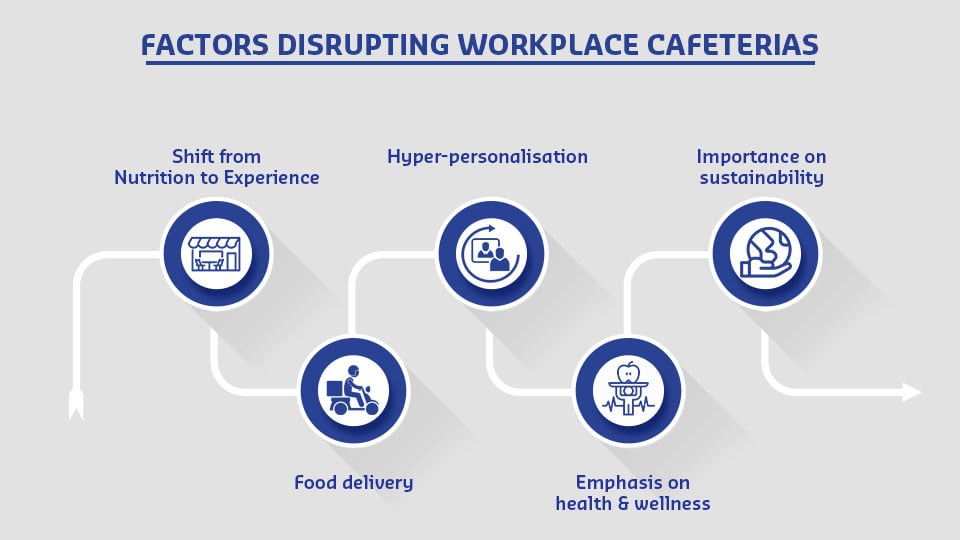
5 Major Trends that Disrupted Food at Work in 2019
A study on food market and consumer trends by Sodexo in association with Oliver Wyman has pointed to a strong disruption in the food market by 2030, largely driven by evolving consumers and client expectations within the corporate segment. Let’s take a look back at the year 2019 to find out in which direction the industry has actually evolved in the past year. The trends will be far more prevalent in 2020.
Disruption in the corporate workplace has definitely taken place. Never before has the employee - the primary consumer of the organization - been given so much importance. Understanding the need for providing employees an enhanced workplace experience - to enrich employee satisfaction, reduce attrition and thereby improve productivity and turnover - organizations have revamped their vision. And since food is a major factor in enhancing employee experience, the traditional workplace cafeteria has undergone a distinct makeover.
The workplace cafeteria is no longer viewed as just a place to have meals; instead it is now looked upon as a space to encourage interaction, collaboration and employee engagement. Therefore, the entire design of the cafeteria has changed; the concept of corporate town halls is trending, so that employees can move around the workplace with ease, and even work in the cafeteria while sipping a cup of coffee. In fact, there have been a few noticeable disruptive trends that have clearly stood out in this year.
Factors Disrupting Workplace Cafeterias

Shift from Nutrition to Experience
The food services model has changed. It has transitioned from the subsidized model to one in which the employee experiences food, much like the cafeterias outside the office. In other words, the food experience outside the office has entered the organization, seamlessly, to fulfill employee aspirations. Food services providers are now reinventing their solutions based on extensive research to address this need. Gone are the low-cost, fixed menus; employees now have a host of options, varied in taste and genre. Food is no longer an avenue to meet the mundane nutrition needs; it has become an exciting experience that is savoured every day.
Food delivery
Traditionally, food was cooked at on-site kitchens and delivered to employees. However, this year, the concept of food delivery has evolved. Keeping in mind organizational limitations related to office space, employee strength and cost, food service providers have now opened up several delivery channels in addition to on-site kitchens. A lot of thought has been given to making quality food accessible to employees from both inside and outside the workplace; leading to the emergence of central kitchens and cloud kitchens. Located at vantage points close to business and corporate hubs, such kitchens provide a variety of food that is tasty, healthy and affordable, to suit the employees’ needs and preferences. As a consequence of this varied food delivery model, related areas like HSE standards, logistics, delivery platform, and technology, have also evolved.
Hyperpersonalisation
Technology has disrupted every space with food services being no exception. Digital has crept into cooking innovation, food app development, payment, and in fact, every aspect related to food. Digital has helped food services track the employee’s food journey in 2019; from browsing food options to ordering and paying conveniently through mobile apps. Data gathered from these apps regarding user preferences has helped in hyperpersonalisation. Menus are tailored and new food items are suggested based on previous choices. Consumers have more options suited to their taste. For example, if a user has been ordering more Indian food items, food services companies ensure that the entire gamut of Indian spread is showcased to the user on the app and more and more variety is added to supplement his satisfaction.
Emphasis on health and wellness
According to the Global Workplace Trends Report by Sodexo, Gen Z, that has newly entered the workplace, expects the organization to place the highest emphasis on wellbeing and quality of life. Their entry reshaped the workplace in 2019; food services started integrating - health and wellness apps, boutique food solutions that help in meal planning, innovative technologies through startup association, and more. This trend is only set to intensify further in the future, ensuring that food accessible to employees is nutritious, tasty and promotes both physical and mental wellbeing.
Importance on sustainability
Gen Z places a lot of importance on sustainability and prefers to work in organizations that have major goals to reduce the carbon footprint. Their obsession with sustainability has led them to be curious regarding the entire food and supply chain before a meal is finally delivered on their plates. The employee wants to know the origin of the raw food materials, its procurement, the entire cooking process and final delivery. Food service companies started placing greater emphasis on procuring organic food materials, maintaining high standards of health and hygiene, conserving the nutrients and delivering a complete experience to the consumer in 2019. Also, there has been more emphasis on lessening food waste and elimination of plastic. Food services companies are integrating apps to monitor food consumed and wasted by employees; thereby tailoring the plate portions. Food is also served in eco-friendly plates. After taking all care, if food is still left over, then it is carefully transported and delivered to the needy, while the nutrition is still intact; benefiting the entire ecosystem.
Thus, 2019 has undoubtedly been the year of the consumers. It has been encouraging to see the innumerable options that the consumer now has in the food space. With technology always evolving, it will be interesting to see in which direction the food services industry progresses next.